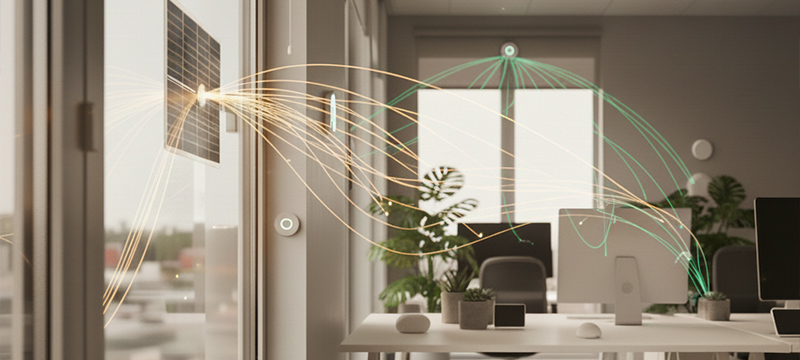

For more than a decade, energy harvesting has been presented as a pathway toward maintenance-free, batteryless IoT devices. Until recently, however, most deployments stayed in pilots due to limited harvested power, variable ambient conditions, and the economics of energy-management components. In 2026, the picture is changing. Better ultra-low-power silicon, more efficient indoor photovoltaics, and corporate pressure to cut battery waste are pushing energy-harvesting IoT into real-world rollouts across multiple verticals.
This year is a turning point not because energy harvesting is suddenly universal, but because a set of high-volume use cases has crossed the threshold into repeatable, scalable business models.
What Has Shifted Since the Early Pilot Era
Three technology layers have matured in parallel. First, embedded chipsets now reach microwatt-level standby and can wake, sense, infer, and transmit on tiny energy budgets. Second, power-management ICs have improved their ability to buffer intermittent energy through supercapacitors and dynamically allocate power between sensing, compute, and radio. Third, indoor and low-lux photovoltaic materials have reached efficiencies that make office, retail, and industrial indoor environments viable energy sources.
These advances strengthen the wider push for long-life and sustainable device fleets
Indoor Photovoltaics Becomes the First Mass-Market Harvester
Indoor photovoltaics (IPV) has emerged as the most commercially mature harvesting mode because light is present in most built environments and predictable enough for engineering. IPV nodes are now being deployed at scale in buildings, warehouses, and retail spaces, notably for occupancy and desk-usage analytics, shelf-stock monitoring, asset presence tags, and environmental sensing (temperature, humidity, CO₂).
Several long-running technology partnerships are now translating into real products. For example, Sequans and e-peas demonstrated an IPV-powered LTE-M/NB-IoT connectivity approach years ago, using indoor light cells to sustain low-duty-cycle cellular IoT sensors—a model that is now resurfacing in commercial designs.
On the logistics side, batteryless tagging is also accelerating. Energous’ recent battery-free e-Sense tag illustrates how IPV-style ambient power and ultra-low-power radios are enabling maintenance-free location and condition tracking in retail and supply chains.
RF Energy Harvesting: Growing, but Still Highly Context-Dependent
RF harvesting is gaining renewed interest in 2025, but remains viable mainly where ambient RF density is high or controlled. This typically means smart retail shelves near access points, industrial environments with dense wireless infrastructure, or access-control zones where tags remain close to readers. In these settings, harvested RF energy can sustain ultra-low-duty-cycle sensors and beacons.
Powercast’s long-standing demonstrations of ambient RF harvesting show the fundamental feasibility of batteryless RF nodes, but also underline that power budgets are tight and strongly location-dependent. Standardisation efforts such as AirFuel RF have also helped clarify interoperability expectations for multi-device RF power environments.
Vibration and Thermal Harvesting Move Into Industrial Reality
In industrial plants, energy harvesting is scaling fastest where input energy is mechanically or thermally abundant. Rotating machinery, compressors, pumps, and hot pipes provide stable sources for vibration harvesters and thermoelectric generators (TEGs). The value proposition is simple: maintenance teams can deploy sensing nodes in hard-to-reach areas without wiring and without battery replacement schedules.
Industrial energy-autonomous cellular platforms, such as the HiSilicon-Nowi NB-IoT reference architecture, illustrate how harvesting plus robust power management can support continuous monitoring without downtime.
Why adoption is accelerating now
Energy harvesting is benefiting from a rare alignment of engineering progress and market pressure. Enterprises are facing higher costs for maintaining massive battery-powered fleets, while regulations and ESG commitments create direct incentives to reduce disposable battery use. At the same time, connectivity stacks are becoming more efficient. The latest LoRaWAN parameter update, for instance, explicitly highlights the role of smaller batteries and photovoltaic support in enabling longer lifetime endpoints.
Where energy-harvesting IoT still does not fit
Despite the progress, energy harvesting remains constrained by physics and environment. Indoor light varies across buildings and seasons; RF energy can be sparse outside controlled zones; vibration-free assets cannot power kinetic harvesters; and many harvesting nodes still need hybrid buffering (supercapacitor or tiny backup cell) to guarantee uptime during long dark or idle periods.
For this reason, successful large-scale deployments usually begin with an energy audit, realistic RF or light mapping, and duty-cycle engineering that matches harvested power to the application’s real data needs.
The road ahead: Autonomous nodes by default
Energy harvesting will not eliminate batteries everywhere, but it is poised to dominate several high-volume categories: smart building sensors, supply-chain tags, retail automation, and industrial condition monitoring. The long-term shift is toward systems that combine harvesting with local intelligence, so nodes transmit only when something meaningful happens.
Batteryless sensors are already established in commercial building automation ecosystems, showing how harvesting can support dependable, maintenance-free infrastructure.
Over time, the convergence of energy harvesting, ultra-low-power radios, and on-device AI will make autonomous IoT nodes a default design choice in many verticals.
Conclusion: 2026 is the year harvesting moves from concept to infrastructure
Energy-harvesting IoT is finally reaching commercial scale in 2026 because the ecosystem has matured enough for specific use cases to deliver reliable power, predictable performance, and measurable TCO benefits. The shift is already visible in indoor photovoltaic deployments, industrial vibration and thermal sensing, and early ambient RF tagging rollouts.
For manufacturers and adopters, the strategic question is no longer whether energy harvesting works, but which device categories can benefit today—and how quickly those deployments can be expanded across operations.
The post Energy-Harvesting IoT: Practical Applications Finally Reaching Scale in 2026 appeared first on IoT Business News.

